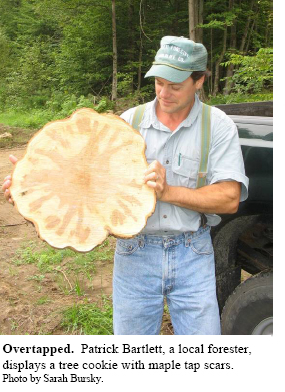At the beginning of the summer I thought that I could study the Prosper Valley's natural landscape without considering the community of people living there; I assumed that the lines between natural and cultural would be clear. I thought that if I explored the steep, bedrock slopes, the flat, soggy fields, and every inch in between, I would somehow know the place.
I had been na´ve; the truth is that there are no lines between natural and cultural landscapes. Every day I spent on the land proved that the natural landscape is inextricably linked to the people who share it. The influences of humans on the land were sometimes obvious, as when a farmer suspended forest succession by pasturing cattle in a field, and sometimes subtle, as when a landowner had removed a few dozen trees each year for firewood. But, even when I walked through the deepest, darkest woods and felt far from the influences of people, I stumbled over stonewalls or into forests of paper birch trees and was reminded that people had once farmed even those hills.
In general, I honored this link between people and the land, but on several occasions during the summer I felt a wave of sadness come over me from the sight of houses being erected in new, geometric gaps in the forest cover. This, in combination with stories from landowners about being unable to pay their property taxes and needing to sell their land to developers, seemed to foreshadow a wave of change that threatens the Prosper Valley I came to know and love—the charming rural character, the uninterrupted ridgelines, and the incredible wildlife habitat. I became bogged down in thinking about the complexities of such a problem and it was not the trees and animals that continually pulled me from the mire, but the people of the Prosper Valley.
Where I found wetlands, I also found the woman who has made it her mission to protect them. She led me on a walk through her woods to some of the treasures hidden within—a vernal pool here, a red maple-black ash swamp there. She explained how the health of wetlands throughout the Valley is tied to everything else—the region's water quality, wildlife habitat, and entire ecosystem functioning.
I was caught in an afternoon thunderstorm with someone who'd offered to show me around his land along the Gulf Brook. We knew the storm was coming when we took off down the old roadbed, but I think we both welcomed the rains. As we walked, he told me that he'd grown up in the area, gone away for much of his adult life, and then was drawn back in his latter years. While the rain drenched us, he told me stories of the critters that used to sneak from the stream banks into the chicken coop to make off with dinner and showed me where the beavers had entirely changed the brook's course.

A local forester who knows the region's hills and hollows like the back of his hand drove me to see an in-progress logging job. He picked up a tree cookie—a horizontal slice of a tree trunk—that was lying on the ground amongst sawdust and pointed out many discolorations radiating from the center. The tree had been tapped for maple sap too heavily at the same height; these discolorations marked the location of scar tissue.
On one very hot summer day, a Barnard Gulf landowner invited me into her home for iced tea and conversation. She told me about how she makes sure the woods roads on her land are maintained so that she can walk through and enjoy the forest. She listened thoughtfully as I shared about interesting places I'd discovered on her land and lamented the days when she could easily ascend to the highest vista.
Two local farmers—a father and a son—gave me a ride in the back of their pickup to the open fields on Dana Hill. The father recollected the building that once stood in the hollow between scraggly lilac bushes and suggested that the tall stonewalls we saw once enclosed a barnyard. The son recalled childhood explorations of the hillside and the scattered vestiges of a farming past—he immediately directed us to a sunken stone cylinder that had clearly been a well.
As I ate lunch, sheltered from the drizzle by the Appalachian Trail's Winturi shelter, I paged through the guest notebook and noticed an entry by someone with a familiar name. He was a nearby landowner who'd been out exploring the land between his home and the trail. A few weeks later I visited him and he led me along a footpath into his woods and wetlands. We passed a cellar hole and collection of stonewalls as he told me stories of the forester who used to work the land and shared his own theories about where the farm fields had once been.
All these conversations with Prosper Valley community members reminded me that many people in the Prosper Valley feel a connection to the land and the landscape. And, though the stories tell of different kinds of connections—some people aim to protect wetlands they understand to be so important, some people preserve the land's history with their memory, some people work hard to see that the land is managed well for the future, and others simply enjoy a walk in the woods—it is these connections between people and the natural world that make a place. And it just might be these connections that save it.